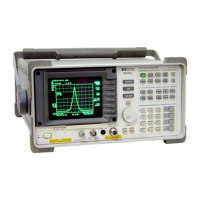Resolving Small Signals Hidden by Large Signals Using the
Resolution Bandwidth Function
When dealing with resolution of signals that are not equal in amplitude, you must consider the
shape of the IF filter as well as its 3
dB
bandwidth. The shape of the filter is defined by the
shape factor, which is the ratio of the 60
dB
bandwidth to the 3
dB
bandwidth. (Generally,
the IF filters in this spectrum analyzer have shape factors of 15:l or less.) If a small signal is
too close to a larger signal, the smaller signal can be hidden by the skirt of the larger signal. To
view the smaller signal, you must select a resolution bandwidth such that k is less than a.
See Figure 3-3.
k
<
a
Figure 3-3. Resolution Bandwidth Requirements for Resolving Small Signals
The separation between the two signals must be greater than half the filter width of the larger
signal at the amplitude level of the smaller signal.
Example: Resolve two input signals with a frequency separation of 200 kHz and an amplitude
separation of 60
dB.
1. To obtain two signals with a 200 kHz separation, connect the equipment as shown in the
previous section, “Resolving Signals of Equal Amplitude Using the Resolution Bandwidth
Function
“.
2. Set the center frequency to 300 MHz and the span to 2 MHz: press
k-1
300
m,
then
ISPAN)
2
IIVIHz).
Note
When using an HP 8590L with Option 713 or an HP 8592L with Option 713,
and the signal peak cannot be found, increase the span to 20 MHz by pressing
ISPAN)
20
INIHz).
The signal should be visible. Press
[PEAK
SEARCH],
(rvlKR),
MK TRACK ON OFF so that ON is underlined. Then (SPAN) 2
INIHz)
to bring the
signal to center screen. Then press MK TRACK ON OFF to OFF to turn the
marker track function off.
3-4 Making Basic Measurements

